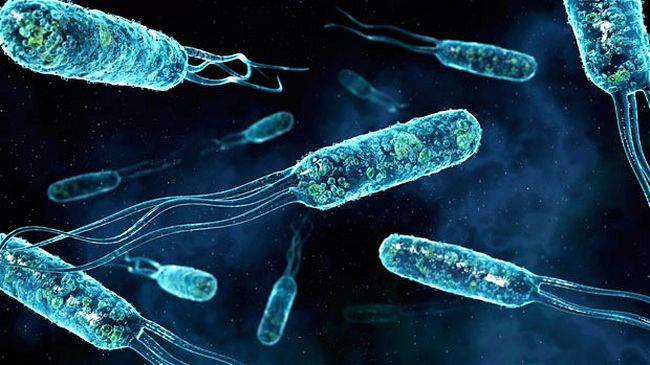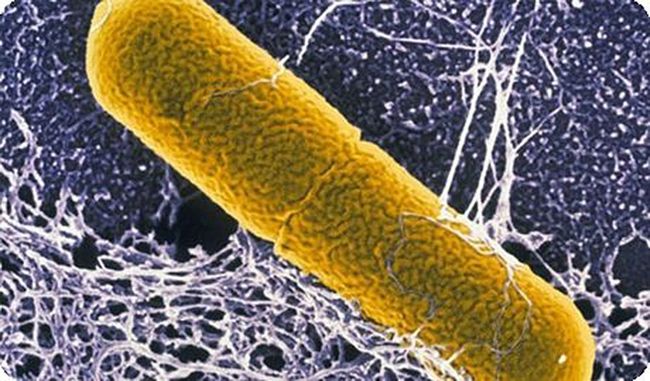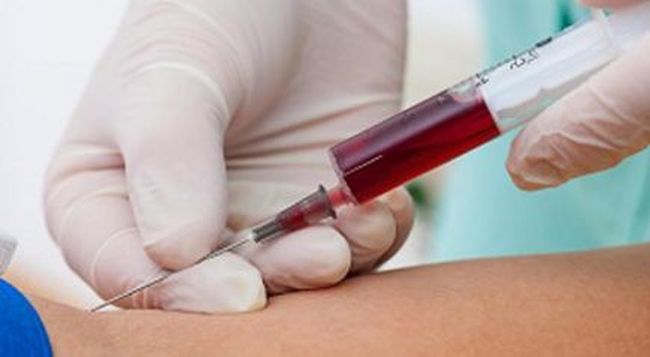Typhoid fever - a disease, which takes place in the intestine in the form of infection. At the same time it affected the entire lymphatic system, the clinical picture is accompanied by a serious intoxication and other characteristic features.
Pathology name coined by Hippocrates. For this he used the Greek term typhos, which can be translated as fog or confusion. For a long time, almost any similar called typhoid fever, dysentery and cholera are no exception. Only after, people learned to distinguish pathogens, pathology began to distinguish.

The causes of disease onset
The causative agent of typhoid fever - a bacterium called Salmonella typhi. This gram-positive bacillus is agile, because she has a lot of flagella. In the environment, the parasite can survive for many months.
Various products are microorganisms, causing infectious diseases, comfortable seating for reproduction. The causative agents of typhoid fever die from frost, but they can be killed by boiling and the effects of chemicals.
Typhoid fever is transmitted from the urine and feces of infected person. Since water and food parasites penetrate the new body and the reservoir. There are cases of chronic diseases such as, when pathogens isolated from human throughout life. Such often leads to epidemics.
Where can I pick up the typhoid?
Typhoid fever, Photos are presented in the article, It can be picked up from food or water, if they contain pathogenic bacteria. Usually, it happens, if infected feces put in liquid. the waters, in turn, able to transmit the disease foods.
Even if the liquid has dried, vital activity of microorganisms is often maintained within a specified amount of time. In particular, they survive in a dried sewage.
The probability of contracting is particularly high, if the ill person, working with food - the chef or the seller. No less dangerous is the disease development in the employee waterworks, as well as those, whose employment is related to the child care.
Most often, in order, to pick up the typhoid, It requires direct contact with clothing, utensils or other objects carrier. Parasite, transmitted with dirty hands - a common case. The causes of typhoid often lie just in problems with personal hygiene.

Course of the disease
The danger of contracting varies at different times of course in human disease. The incubation period of typhoid fever is safe enough for others. Bacteria begin to stand out from the products of human activity after about two to three weeks. In addition to sweat, feces and urine, they also may be in breast milk.
Between typhoid infection and relief from pathogens passes, usually, about two weeks. but, the process of restoring the normal functioning of the body and may take two to three months. A small percentage of recovered are chronic carriers of the parasite to the end of life.
Pathogenesis of typhoid:
- Overcoming the mouth, Salmonella reach the lymph follicles in the small intestine.
- There comes a primary breeding.
- Thereafter, the parasite enters the bloodstream, leading to the onset of bacteremia and other pathological phenomena.
- All this is accompanied by severe intoxication of the body.
- Using the parasite enters the bloodstream to the liver, spleen and other organs.
- In the bone marrow and lymph nodes can form large granulomas.
- With their help, the bacteria are able to attack the second person.
- In the later weeks of necrosis often occurs, formed ulcers.
At this time, others may actively infected, as the parasites continue to be transmitted through the feces. Sometimes the end of the disease does not mean to stop the discharge of dangerous microorganisms. This includes cases and chronic carriers.

Symptoms of typhoid
Incubation of the disease can last for several days, but more often a term is 10-14 day, although it can reach up to three weeks. Symptoms of typhoid fever begin to appear in the initial period.
- For the gradual development characterized by fever. This occurs in the first three or four days, while the thermometer can show up to 39-40 degrees Celsius.
- From the very start begin to show symptoms of intoxication. These include headache and anorexia, as well as a person develops weakness, there are dizziness and trouble sleeping.
- Sometimes toxicity manifests itself to increase the temperature, the first two days.
Intestinal infection typhoid fever and cholera may be something similar, but if the second is characterized by diarrhea,, the first is often accompanied by constipation.
In the initial stages of the disease, many patients notice pale skin, but the acute course of the face is hyperemic. Symptoms include thickening of the tongue and the appearance of plaque in the middle portion. An increase in the size of say in the wake of the teeth, who are often on the edges.
typhoid disease begins to manifest itself widely in terms of the digestive tract. develops flatulence, due to which the stomach swells, slows peristalsis. In the early stages, many not found constipation, and loose stools, which is often called "pea".

Further development of the disease
If in the beginning can be detected by palpation pain in the right iliac region, then after three days will increase the size of the liver and spleen. Although they will be palpable seal, pain will be no.
Infection with typhoid fever is often accompanied by the muffled tones of the heart, and a later date it goes into bradycardia. Sometimes rapid pulse acts as a symptom of disease. Around the end of the second week of fever and intoxication are particularly strong.
- The rash of typhoid fever usually appears at the beginning of the second week of illness. Speakers called roseola, which are slightly raised above the skin. Usually, a rash appears on the front of the abdominal wall and bottom of the breast.
A person develops several major roseola, about three pieces, which extend four days later. After that may rub other manifestations.
note! Sometimes the diagnosis "typhoid fever" does not mean, It is sure to develop rash. The disease is able to proceed without such rashes.
Earlier in the course of disease sometimes develops typhoid status, but today like quite rare. About the beginning of recovery, Firstly, He said reducing the temperature, and then begin to weaken and signs of intoxication. With the disappearance of the symptoms for a while stored ulcers in the intestine, therefore it is necessary to monitor the possible bleeding.
special cases
Symptomatology of typhus may be slightly different, if there are other forms of. for example, dysentery and typhoid are atypical, also found abortive appearance, which quickly passes. We erased the weakest variant symptoms.
Allocate specific types of typhus, associated with other diseases. for example, there pnevmotif or nefrotif. Finally, A number of acute infections, which are very similar to the disease. It - paratyphoid A, B and C.
Paratyphoid disease often affects the large intestine and thus have little effect on the lymphatic system. A view of the symptoms in many respects similar to SARS, and B - with gastroenteritis. Distinguish Variant C can be on the skin jaundice and muscle pain.
Typical complications of typhoid fever:
- Bleeding in the gut,
- wall perforation,
- peritonitis,
- pneumonia,
- otitis,
- bedsores on bed rest.
It is better not to bring up the late stages of the disease, and in a timely manner to carry out analysis on typhoid fever.
diagnosis of the disease
Treatment begins with typhoid diagnosis. Firstly, the patient's medical history is collected, and then carried out the bacteriological and serological testing. A blood test for typhoid fever - is one of the fundamental steps, as it allows you to detect parasites in the early stages.
To start, you need to donate blood for typhoid, but doctors may also require the feces and urine. Besides, laboratory diagnosis of typhoid fever as the recovery is used to assess the state of the duodenum.
You can not donate blood and expect instant results. Most often, accurate data can be obtained after about five days. If a blood test for typhoid disease confirmed, the patient is placed on the patient treatment - the only way to appropriately take care.

Treatment and prevention
For, to determine typhoid, pass a series of tests, and then the patient gets to the hospital, where it will be a long time only in the supine position. The patient is prescribed antibiotics, mixtures of intoxication, as well as preparations for the cardiovascular system, if necessary.
Prevention of the disease includes personal hygiene, thorough washing of various raw foods and consumption of only pasteurized milk. Graft, ie vaccination against typhoid fever, epidemiologists carried out only in case of a possible mass infection.












